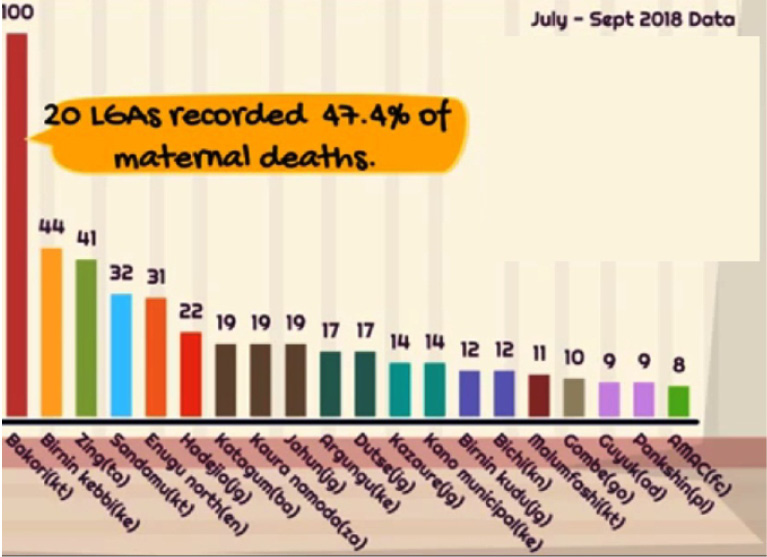Where Nigeria’s women die the most
A total 971 women died from pregnancy-related causes in hospitals between July and September this year, according to routine data on the national health management information system. The data also shows a total 8,085 children died within the same three-month period. The women died in 35 states combined, in a total 320 health facilities across 228 […]

A total 971 women died from pregnancy-related causes in hospitals between July and September this year, according to routine data on the national health management information system.
The data also shows a total 8,085 children died within the same three-month period.
The women died in 35 states combined, in a total 320 health facilities across 228 local government areas.
The data is collected routinely by local government health officers and uploaded to a national database managed by the federal health ministry.
The child deaths were reported from 37 states, spanning 483 local government areas and 1,311 health facilities.
The National Health Act calls for a health management information system. It calls for local health officers to routinely submit data to the database from across facilities.
Nigeria uses a platform called DHIS2, considered the world’s largest. A total 67 low and middle-income use the platform to track health indices covering close to 2.3 billion people.
Digging into DHIS2
It was deployed to help the health sector manage and analyse data on custom dashboards to monitor and evaluate health programmes. It double as a registry of facilities and maps where services are available, according to its makers.
It also helps manage logistics and mobile tracking of pregnant mothers in rural communities.
Nigeria’s DHIS2 platform holds nearly 300 data sets, to be analysed for anything from malaria testing to HIV counselling. The nature of the DHIS2 allows analysts to drill through national data and filter down to individual state, local government area and right down to single facilities.
Between July and September, it shows 971 women and 8,085 children died. The deaths are only those reported by health facilities.
The inference is that many more deaths go unreported; not talked about due to beliefs or just undocumented.
States where women are dying most
Nearly 74% of all 971 deaths among women in the period was in only 10 states.
Katsina is first among states with the highest deaths reported. A total 191 women died from pregnancy-related causes in Katsina.
Jigawa is next, with 113 women dead in the period. Kebbi, Kano, Bauchi and Adamawa up to Gombe and Zamfara account for the most deaths of woman. The group of states also curiously includes Lagos, highest among southern states, with 41 women dead within the period.
Seven conditions were responsible for the deaths. A total 529 women died from pre-eclampsia, a pregnancy complication that comes with high blood pressure and causes damage most often the liver and kidneys. The next cause of death recorded for 437 women was malaria. Infection accounted for 101 deaths in pregnant women, far more than 65 deaths linked to obstructed labour.
See the children dying
And 8,085 children aged under five also died in the period-64 in every 100 of the deaths were in 10 states.
A total 1.018 of the children were in Katsina. Lagos had the fourth highest number, with 519 children dying in Lagos. More children died in Lagos in three months than in Yobe or Adamawa, parts of which face insurgency-related problems.
A total 5,712 of the children died from malaria, top among four major conditions responsible for child deaths within the period. It surpassed the total number of children who died from diarrhoea, malnutrition and pneumonia combined.
Level of death, primary secondary tertiary
Analysts at the Initiative for Health Accountability and Transparency got interested in the DHIS2 data and began drilling deeper to find out the facilities where women and children died the most.
Nearly 56% of all the deaths were in 40 health facilities: 15% of them were primary health centres, 55% of them secondary health centres. Three out of every 100 deaths were in tertiary health centres.
Dr Mohammed Abdullahi, public health expert at IHAT, says the finding was “disturbing” and signals a weakness in hospital referrals.
“We have a three tier system-primary, secondary and tertiary-and they are supposed to be effectively linked. Unfortunately you see a lot of deaths at primary care level, especially of women and children. You don’t expect that, because the expectation is that serious cases are supposed to be referred to the next level.
“That is not happening. The primary health centres are becoming specialist centres to handle very sophisticated cases.”
IHAT has started a periodic newsletter that mines data from the DHIS2 and compiles visualizations to connect the public to health situation based on routine data.
The wide use of the data coming out of DHIS2 is limited by how diligently health officials feed their data into the database, a public health expert in Zamfara told Daily Trust.
Despite the limitation, what is reported is significant, analysts say.
But the dashboard shows a reality that is coming close to what surveys suggest.
“Surveys are based on sample population, and they make inference to what happens in larger populations,” says Abdullahi.
“What we have is not a survey. It is what is actually happening in the population.
“When they tell you close to 1,000 women have died in a quarter, and you and I know there may have been underreporting, then there is need for us to look at these numbers.”
